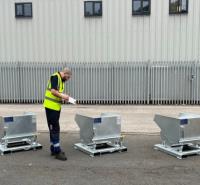 Add My Company
Add My Company
Sign In

Forklift attachments are used by many companies on a daily basis and due to familiarity, it can be easy to become complacent when it comes to safety requirements. If used incorrectly, forklift trucks can do some serious damage - potentially causing serious harm to yourself and others. Here are our top tips for ensuring safety of your forklift attachment
Check the Forklift Attachment for Damage or Wear
As with any equipment, forklift attachments must be checked regularly for signs of damage or excessive wear and tear. Damaged or excessively worn forklift attachments designed for lifting (e.g. forklift jibs, forklift hooks) can, for example, affect its structural integrity - posing a risk of failure once the attachment is under load. Similarly, wear and tear of safety areas such as the locks and securements could result in the attachment disengaging from the forklift truck, potentially causing a serious accident.
Check the Load & Capacity of the Forklift Attachment
It?s important to know the limitations of your forklift attachment with regards its lifting capacity. Lifting beyond the capacity of the attachment can damage it and significantly increase the risk to health and safety. The Safe Working Load of the forklift attachment should be clearly labeled and identifiable on the product at all times.
Make Sure the Forklift Attachment and the Forklift Forks Are Correctly Matched
forklift forksWith the majority of forklift attachments being of the fork-mounted variety (where the operator drives the forks of the forklift into the pockets of the attachment) it?s important to ensure the sizing of the attachment fits that of the forklift truck. For example, using fork pockets that are too large for the forks, any securing methods on the attachments could be compromised.
Check Your Forklift Truck?s De-Rated Load Capacity
forklift extension incorrect useWhen fitting a forklift attachment, the capacity of the forklift truck is affected. This is known as the ?De-Rated? capacity. The weight of the attachment, combined with the weight of the product to be handled and the distance from the attachment to the forklift truck will all have a bearing on the forklift?s lifting capacity. It?s important, therefore, that you check how your attachment will affect your truck?s safe handling capacity. If in doubt, always check with your forklift supplier.
Is the Forklift Attachment Fit for Purpose?
Never ?make do? with using a forklift attachment that has not been specially designed for the material handling task at hand. Using an attachment in the wrong way can hurt you and others around you, not to mention cause damage to the product and potentially render insurance invalid.
Is the Attachment Suitable for Its Working Environment?
atex certifiedSome forklift attachments are specifically designed for the environment they are to be operated in. For example, in hazardous and explosive environments, using an attachment that isn?t ATEX certified could prove catastrophic.
Similarly, in more demanding environments such as a construction site or quarry, a heavy duty tipping skip is highly recommended over a regular duty skip.
Can the Attachment Be Safely Secured?
fork extension heel pinSecuring the forklift attachment to the truck safely is paramount. The majority of fork-mounted attachments will come with either retaining pins, retaining bars (both of which lock behind the heel of the fork) or ?T? Screw clamps (which clamp down onto the top of the fork). Safety chains that fasten to the forklift carriage may also be used on some attachments such as forklift tipping skips for added safety. Never use your forklift attachment if it is missing any of these securing methods.
Check When Your Latest LOLER Inspection Was Carried Out
thorough examinationUnder LOLOER 98, your forklift attachment must undergo a periodic Thorough Examination (6 monthly or yearly dependant on the type of attachment) which is akin to a car?s MOT. If your forklift attachment has not undergone this examination and inspection in accordance with the schedule, you may be at risk of prosecution by the HSE. It can also invalidate insurance and put you and others around you at higher risk. Look out for the Thorough Examination date reminder which should be easily identifiable on your attachment.
Does the Attachment Have a Valid Test Certificate
Without a valid test certificate, your forklift attachment would be deemed illegal and not fit for use. Any of these could impact the validity of your test certificate:
Has your attachment been inspected in accordance with its Thorough Examination obligations?
Has your attachment undergone any remedial work and not been recertified?
Conclusion
Whatever industry you work in, whether construction, logistics, or pharmaceutical, you have a duty of care to ensure that your attachment and all equipment used with your forklift truck are legal, fit for purpose, and above all, safe. For any questions about LOLER certification, load handling capacities, or design or securing methods, please contact a member of the Contact Attachments team today.
For more information on Safety Checks Needed Before Using A Forklift Attachment talk to Contact Attachments
Enquire Now
List your company on FindTheNeedle.

